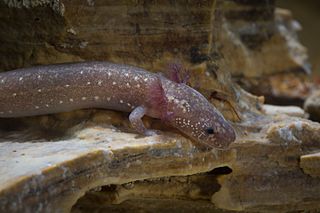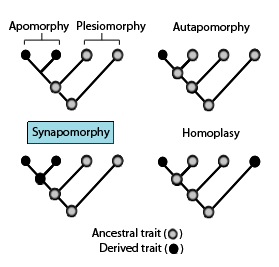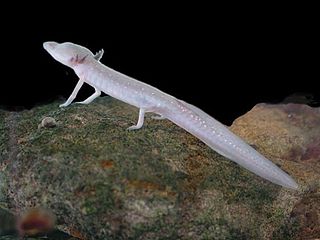Related Research Articles

The Barton Springs salamander is an endangered lungless salamander. It is endemic to Texas, United States. It was first found in Barton Springs in Austin, but is now also known from other localities in the nearby Travis and Hays Counties. Barton Springs is located within Zilker Park which is situated in the Edwards Aquifer in Austin, Texas. Eliza Springs, located within Barton Springs, has one of the largest populations of Barton Springs salamanders.

In phylogenetics, an apomorphy is a novel character or character state that has evolved from its ancestral form. A synapomorphy is an apomorphy shared by two or more taxa and is therefore hypothesized to have evolved in their most recent common ancestor. In cladistics, synapomorphy implies homology.

The Texas blind salamander is a rare and endangered cave-dwelling troglobite amphibian native to San Marcos, Hays County, Texas, specifically the San Marcos Pool of the Edwards Aquifer. This species resembles the olm, another stygofaunal salamander from Europe. Unlike the olm, this amphibian's body is not as elongated, and also has less reduced digits on its limbs.

The Valdina Farms salamander is a species of aquatic salamander described from Valdina Farms Sinkhole in Medina County, Texas, United States. It is sometimes referred to as the Valdina blind salamander or sinkhole salamander. As some other species of Eurycea found in Texas, it was once classified as a subspecies of the Texas salamander, Eurycea neotenes, and believed to possibly be the result of hybridization with another species of subterranean salamander, but was granted full species status in 2000. Research is ongoing, and some sources suggest the current species may actually be multiple distinct species.
The Comal blind salamander or Honey Creek Cave blind salamander is a small species of aquatic, lungless salamander native to the United States. It is endemic to a small region at the junction of Comal, Bexar and Kendall Counties in Texas. It is 1.5 to 3.0 in long, with a slender body and external gills, and is an overall translucent pink color.
The Blanco blind salamander is a species of aquatic, lungless salamander native to the United States. It is endemic to a small region of the Blanco River near San Marcos in Hays County, Texas. Its habitat, deep in limestone karst, makes collecting specimens for research particularly problematic. It is known from only a single specimen, collected in the 1950s.
Eurycea neotenes, also known as the Texas salamander, Bexar County salamander, Edwards Plateau salamander, or Texas neotenic salamander, is a species of entirely aquatic, lungless salamander native to the United States. It is endemic to central Texas, near Helotes, in Bexar County.
The Salado Springs salamander is a species of salamander in the family Plethodontidae. It is endemic to the vicinity of Salado, Texas.

The Georgetown salamander, also known as the San Gabriel Springs salamander, is a species of salamander in the family Plethodontidae. It is endemic to springs in Williamson County, Texas, near Lake Georgetown. It inhabits freshwater springs and, possibly, caves. It is threatened by habitat loss. Many of the springs where this species formerly lived have been destroyed by development, including creation of Lake Georgetown. The specific name refers to the few remaining remnants of habitat for this species.

Hyloidea is a superfamily of frogs. Hyloidea accounts for 54% of all living anuran species. The superfamily Hyloidea branched off from its closest relative, the Australobatrachia, during the mid-Cretaceous. The fossil evidence found during the Cretaceous-Paleogene extinction event could not determine the effects upon the frogs, due to the lack of fossils. Increased forestation erupted after this extinction, possibly leading to more arboreal adaptations of these anurans to be best suited for this habitat.

The Salientia are a total group of amphibians that includes the order Anura, the frogs and toads, and various extinct proto-frogs that are more closely related to the frogs than they are to the Urodela, the salamanders and newts. The oldest fossil "proto-frog" appeared in the early Triassic of Madagascar, but molecular clock dating suggests their origins may extend further back to the Permian, 265 million years ago.

Leslie Jane Rissler is an American biologist best known for her work on amphibian and reptile biogeography, evolutionary ecology, systematics, and conservation, and for her strong advocacy of improving the public’s understanding and appreciation of evolution. She is currently Program Officer in the Evolutionary Processes Cluster of the Division of Environmental Biology and Directorate of Biological Sciences at the National Science Foundation.

Hyloscirtus hillisi is a species of tree frog native to the Cordillera del Cóndor in Ecuador at elevations of 6,532 to 7,001 feet. The species is in danger of extinction.
David C. Cannatella is an American herpetologist, systematist, zoologist, and professor of integrative biology at the University of Texas at Austin.
References
- 1 2 3 "Reorganization of Biological Sciences, UT Austin". Archived from the original on 2011-07-20. Retrieved 2009-01-01.
- ↑ "2011 National Officer Election Results". Archived from the original on 2011-05-01. Retrieved 2011-01-02.
- ↑ Levy, Steven (2005-10-10). "The Mind of an Inventor". Newsweek . Archived from the original on 2007-03-29. Retrieved 2007-04-29.
- ↑ "Johns Hopkins, Neurology & Neurosurgery, Dr. Argye Hillis". Archived from the original on September 19, 2008. Retrieved 2009-01-01.
- ↑ Hillis, David M.; et al. (1996) [1990]. Molecular Systematics. Sinauer Associates. ISBN 0-87893-282-8.
- ↑ Sadava, David; et al. (2011) [2008]. Life: The Science of Biology, 9th ed. Sinauer Associates and W. H. Freeman. ISBN 978-1-4292-1962-4.
- ↑ Hillis, David M.; et al. (2010). Principles of Life. Sinauer Associates and W. H. Freeman. ISBN 978-1-4292-5721-3.
- ↑ "Hillis and Bull Laboratory" . Retrieved 2009-01-01.
- ↑ Wray, Kenneth P.; Means, D. Bruce; Steppan, Scott J. (December 2017). "Revision of the Eurycea quadridigitata (Holbrook 1842) Complex of Dwarf Salamanders (Caudata: Plethodontidae: Hemidactyliinae) with a Description of Two New Species". Herpetological Monographs. 31 (1): 18–46. doi:10.1655/HERPMONOGRAPHS-D-16-00011. ISSN 0733-1347. S2CID 90138747.
- ↑ Ron, S. R.; Caminer, M. A.; Varela-Jaramillo, A.; Almeida-Reinoso, D. (2018). "A new treefrog from Cordillera del Cóndor with comments on the biogeographic affinity between Cordillera del Cóndor and the Guianan Tepuis (Anura, Hylidae, Hyloscirtus)". ZooKeys (809): 97–124. Bibcode:2018ZooK..809...97R. doi: 10.3897/zookeys.809.25207 . PMC 6306478 . PMID 30598617.
- ↑ Jiang, K.; Ren, J.; Wang, J.; Guo, J.; Wang, Z.; Liu, Y.; Jiang, D.; Li, J. (2020). "Taxonomic revision of Raorchestes menglaensis (Kou, 1990) (Amphibia: Anura), with descriptions of two new species from Yunnan, China". Asian Herpetological Research. 11: 263–281.
- ↑ Torres-Carvajal, O.; Venegas, P.; Lobos, S. E.; Mafla-Endara, P.; Sales Nunes, P. M. (2014). "A new species of Pholidobolus (Squamata: Gymnophthalmidae) from the Andes of southern Ecuador". Amphibian & Reptile Conservation. 8: 76–88.
- ↑ Pérez-Ramos, E. (2023). "Two other new species of Rana (ANURA: RANIDAE) in the Mexican Pacific coasts of Guerrero and Sinaloa". Revista de Zoología. 35: 1–18.